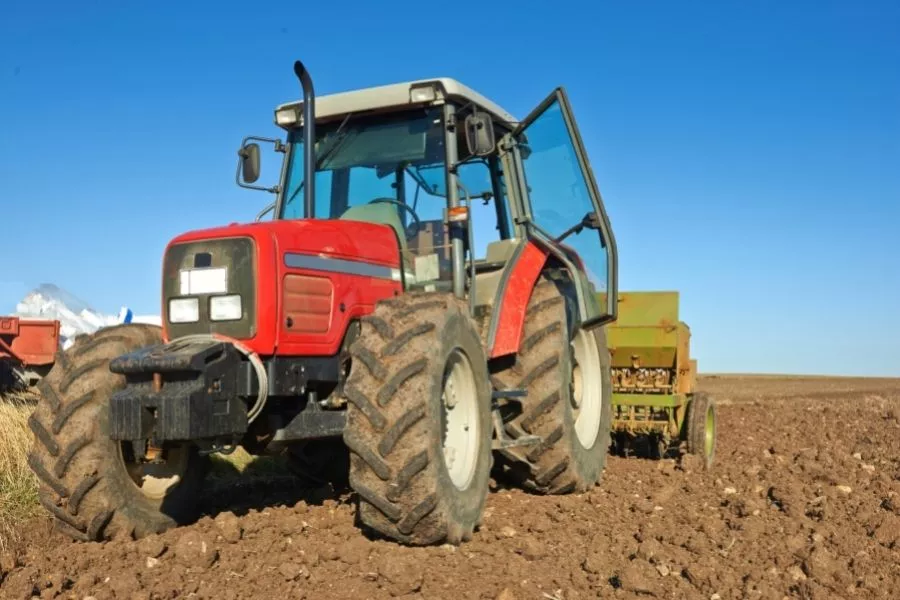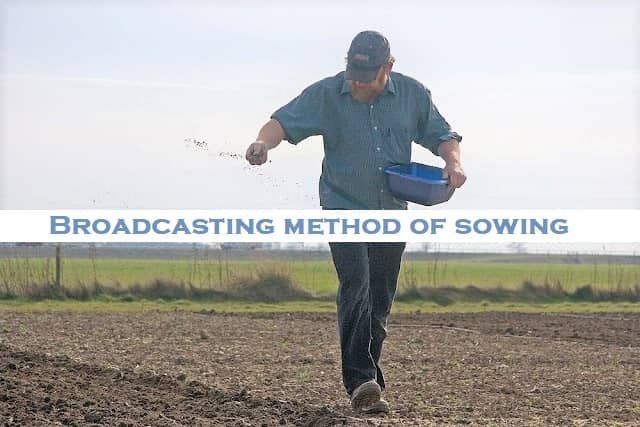The broadcasting method of sowing is one of the most widely used methods for seeding on the ground. It is a simple and effective method that can be implemented in a wide range of agricultural practices.
Broadcasting seed on the ground is done by broadcasting seed in a thin layer across an area and then covering it with soil. The seeds are broadcasted at a distance from each other so that they do not touch each other. This ensures that there won’t be any competition for resources, such as water or nutrients, between the different plants.
The broadcasting method of sowing helps to maximize yields and ensure high germination rates while minimizing weed growths.

Definition of sowing seeds
Sowing is placing a specified quantity of seeds in the soil in the optimum position for germination and growth. At the same time, planting is putting plant propagules (maybe seeds, seedlings, cuttings, tubers, rhizomes, clones) into the ground to grow as crop plants. Seeds are sown either directly on the field (seedbed) or in the nursery (nursery bed), where seedlings are raised and transplanted later.
Methods of planting
Planting methods may broadly be classified as follows:
- Direct seeding
- Transplanting
1. Direct seeding: It is the practice of using seed directly as the planting material. Direct seeding may be done by:
- Broadcasting
- Dibbling and
- Drilling
Broadcasting method of sowing seed in agriculture

Broadcasting is a widespread method of sowing seeds. Broadcasting is the process of random scattering or spreading seeds on the surface of seedbeds that may or may not be incorporated into the soil or covered with soil or similar other materials.
In agriculture, broadcasting is the process of scattering seeds or fertilizer evenly over an area. A broadcaster is an implement used to do this. The most common type of broadcaster is the rotary type, which has a spinning wheel with evenly spaced holes that deposit the material being broadcasted. Broadcasting is done either by hand or with a power tool.
Hand broadcasting is done by scattering the material in one hand and then tossing it out with a back and forth motion. Power broadcasting is done with a device that attaches to the back of a tractor and scatters the material while it is pulled along.
Broadcasting is a quick and easy way to sow seeds, and it can be done in any kind of weather condition. It also ensures that the seeds are distributed evenly over the area, which helps them to germinate and grow properly.
Broadcasting of seed can be done manually (by hand) and mechanically (mechanical spreader or airplane). Seeds are broadcast on the soil having sufficient moisture for the germination of seed. Seeds may also be broadcast in the wet field.
The germinated (sprouted) rice seeds air generally sown by this method. In the wetland, when broadcasting is done manually, the uniformity of scattering seeds depends on the man’s skill. Under the dry condition, the seeds must be covered with soil by planking or laddering or some other devices just after the sowing is completed.
When broadcasting is done mechanically, a machine is used for scattering the seed on the surface of the seedbed at controlled rates. Broadcasting has some advantages and disadvantages as follows:
Advantages of broadcasting in agriculture

This method is suitable for close planted crops that do not require a specific geographic area for the optimum expression of their morphogenesis and development. They are more plastic to compensate the morphological structures according to prevailing conditions.
In situations where the number of plants per unit area (per m2) is more important than that of definite spacing from plant to plant, broadcasting is the usual method of sowing. Crop plants not requiring special cultural practices (earthing up or picking) may be sown by broadcasting. Other advantages are as follows:
- It is an easy, quick, and cheap method of sowing seed.
- More land can be covered within a short time.
- No need for sowing implementation.
- Cost of sowing becomes less.
- Broadcasting is the usual method of sowing seed for mixed cropping.
- Broadcasting needs less labor.
Disadvantages of broadcasting in agriculture
Though the method is an easy, quick, and cheap method of seeding, there are difficulties in uniform distribution, placing the seed in the optimum and uniform depth of soil, and providing soil cover and compaction. As not all seeds are placed in uniform depth, there is no evenness of germination and uniformity in seedling establishment. Other disadvantages are:
- The requirement of seed per area is more.
- The cost of weeding and thinning in the broadcast crop is more.
- The intercultural operations such as earthing up, manuring, irrigation, etc., cannot be carried out with ease.
- Broadcasting needs planking for covering the seed with soil. On the other hand, drilling needs no planking.
- Broadcast crops do not grow uniformly, and the desired yield is not possible. Moreover, the prediction of the expected outcome becomes erroneous.
Field condition for broadcasting
Broadcasting of seeds is done in dry, semi-dry, and wet fields. For sowing in wet fields, seeds must be soaked with water for eight to twelve hours and incubated for a few hours so that the radicle just begins to emerge from the seed.
Crops such as upland and flooded rice, oats, wheat, millets, mustard, jute, black gram, fodder crops such as berseem, lucerne, sorghum, and spices as coriander and cumin are generally sown by this method. For mixed cropping, broadcasting is the usual practice of sowing seeds.
In conclusion, broadcasting is an efficient and economical way to sow crops in a large area. It is a suitable method for farmers who have a large plot of land. The broadcast seeder is easy to operate and does not require any special skills. It is important to make sure the correct amount of seeds is used so that the crops will grow successfully.
